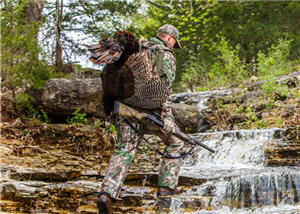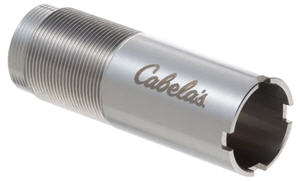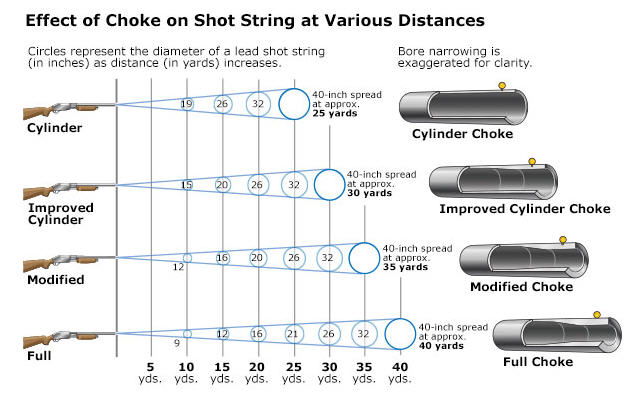
Choke tubes can turn one gun into several specialized guns, depending on the choke tube that is in the barrel. If you hunt with shotguns try these tips on how to pick the right choke for your style of shotgun shooting. In this article you'll find information on the most commonly used choke tubes, specialty tubes, the benefits of choke tubes and gun pattern spread for various chokes.

Many hunters give it little thought, but one of the inventions most significant to those who hunt with shotguns is the choke tube — a simple device that allows one to change a gun's choke and thus alter its pattern and range so a single shotgun can be used effectively in a wide variety of hunting and/or shooting situations.
Before the invention of choke, all barrels were simply straight tubes with an effective killing range of about 25 to 30 yards. Hits beyond that distance were a matter of luck. The advent of choked barrels ushered in a new age in shotgunning.
A Short History of a Shotgun Choke
The first patent for a shotgun choke was granted in 1866, but it wasn't until 1969, more than a century later, that Winchester introduced the WinChoke on its Model 1200 and Model 1400 shotguns. The company's Versalite choke had appeared on its Model 59 autoloader eight years earlier, but the WinChoke was the first widely popular, interchangeable choke-tube system. In 1978, Mossberg introduced its new Accuchoke tube system on its Model 500, followed in 1982 by the Multichoke on Weatherby's Model 82. By the early 1980s, all shotgun manufacturers were working on and releasing their own versions of the successful screw-in choke tube we're all familiar with today.
Although decades passed before the choke-tube idea became universally accepted by hunters, the eventual adoption of this interchangeable system by shotgun manufacturers increased the scattergun's versatility by leaps and bounds and saved shotgunners lots of money as well. No longer is it necessary to buy extra barrels to have different choices in chokes. Many of today's shotguns come equipped with a variety of screw-in chokes that can be quickly changed with the twist of a wrench. And many specialist companies offer retrofitting of fixed-choked guns, as well as custom-design replacement choke tubes for factory-threaded barrels.
Types of Choke Tubes

A choke tube constricts a gun's shot charge to hold it together longer before the shot spreads, thus giving a denser shot pattern at longer range than an open choke or no choke at all. In some ways, it's comparable to the nozzle at the end of a garden hose, controlling the spread of shot like the nozzle controls the spray of water, making it narrower or wider as needed.
A choke tube also determines to some extent the shotgun's effective range. The tighter the constriction of the tube, the farther the range. For example, a full choke is most effective at 40 to 50 yards; an improved cylinder is most effective from 20 to 35 yards.
The Most Commonly Used Choke Tubes are These:
- Super-Full/Extra-Full: Two choke types sometimes called "gobbler getters," these are ideally suited for the head shots necessary when turkey hunting. They have extra-tight constrictions and the densest patterns.
- Full: This choke has tight constriction and a dense pattern, delivering approximately 70 percent of a shell's total pellets in a 30-inch circle at 40 yards. It's often used for trap shooting, waterfowl pass shooting, turkey hunting and buckshot loads.
- Modified: This choke has less constriction than a full choke, delivering approximately 60 percent of a shell's total pellets in a 30-inch circle at 40 yards. It's great for general waterfowl hunting and hunting distant-flushing upland birds and small-game animals such as late-season pheasants and rabbits. Also used for trap shooting.
- Improved Cylinder: Even less constricted than modified, the improved cylinder distributes approximately 50 percent of a shell's total pellets in a 30-inch circle at 40 yards. This often is the choice of hunters shooting waterfowl close over decoys or pursuing close-quarters upland birds such as quail, grouse and pheasants. Rifled slugs usually perform well with this choke.
- Cylinder: With no constriction, this choke distributes approximately 40 percent of a shell's total pellets in a 30-inch circle at 40 yards. It's most often used by law enforcement for service shotguns.
- Skeet: This choke distributes approximately 50 percent of a shell's total pellets in a 30-inch circle at 25 yards. It's designed to deliver optimum patterns for close-range skeet shooting.
What are Specialty Choke Tubes?

such as the Hevi-Shot Hevi-Choke Waterfowl
Choke Tube
Specialty choke tubes are built for certain types of shot. For example, the steel shot required when hunting waterfowl is harder on shotguns than lead shot and patterns differently than lead. Waterfowl choke tubes are built stronger than traditional choke tubes made only for lead shot. They also are built so steel shot, which doesn't pattern as well as lead shot, will hold a tighter pattern. There also are specialty tubes made specifically for use with Hevi-Shot, tungsten and other materials.
Skeet and trap shooting enthusiasts often use high-quality specialty tubes as well. They know a quality choke tube can increase a shotgun's effective range, and a strong, well-built choke tube also protects the gun barrel and, in some cases, helps reduce gun-barrel stress caused by heat. When a tournament is on the line, skeet and trap shooters want the edge they gain when using a good choke tube.

made to exacting factory specifications
Several choke-tube companies also make specialty choke tubes for the growing predator-hunting market. These are constructed especially for use with large shot pellets such as buckshot favored by those who hunt coyotes, bobcats and other large predators. Some companies claim their predator-hunting tubes consistently hold tight patterns to 70 yards.
The Benefits of Choke Tubes
Screw-in choke tubes such as the Cabela's Choke Tubes sold at Bass Pro Shops give shotgunners the option of conveniently and inexpensively trying different constrictions with different loads. If you hunt quail or rabbits in thick brushy cover where most shots are taken inside 20 yards, for example, you probably need the largest pattern your gun will shoot while maintaining adequate pellet density. If your shotshells are delivering overly tight patterns for those conditions, just unscrew the modified or improved-cylinder choke and screw in a skeet or cylinder choke.
Moving to the opposite extreme, if your ammo doesn't deliver a dense enough pattern at 30 yards for consistent multiple pellet strikes on rice-field geese, replace the modified choke with full or perhaps extra-full. But be careful when using extremely tight chokes as once the optimum amount of choke is reached for a particular load, a further increase in constriction actually may have a negative effect on pattern quality.
Patterning the Choke Tube & Load Combination
Because different guns pattern differently, even with the same load and choke, the only way to know for certain how a choke tube/load combination will perform downrange is to pattern-test it on paper.

Click here for a larger view of the chart showing gun pattern spread for various chokes and distances.
If you hunt waterfowl, this also is important because steel shot patterns differently than lead. (You should shoot a more open choke with steel than you would with lead to get a similar pattern density at a given range.) Many other variations can affect performance as well — copper-plated versus straight lead, for example — making it important to check how your gun performs with a certain load and choke tube.
Start by obtaining choke tubes indicated for the type shooting you do and pattern them with your favorite load. To do this, shoot off a rest at a center mark in a 30-inch circle at 40 yards. Full choke should put 70 percent of the shot in the circle, modified 60 percent, improved cylinder 45 percent. Cylinder, or no choke at all, should shoot from 25 to 35 percent.

same shotgun for hunting up-close decoying ducks in the morning and pass-shooting longer range geese in the afternoon.
If, for example, the ammo you are shooting is loaded with 1-1/4 ounces of No. 2 steel shot, it contains approximately 156 pellets. If you count 94 pellet holes, your shotgun placed 61 percent of the shot charge inside the circle, revealing that the load is delivering modified performance. To get a better picture of how the gun is performing, shoot at least five patterns with the same load and average the results.
If your pattern test reveals less than satisfactory performance for the type shooting you do, try a couple of different loads — maybe up or down a shot size or slightly hotter or less powerful. If that isn't satisfactory, spend $20 or so on a new choke tube and either tighten or loosen the choke one size before patterning again. Sooner or later, you'll hit a combination ideal for your shotgun.
To determine the maximum effective range of a choke/load combination, you also can try this method. Let's say you do a lot of wingshooting. Start by shooting paper at 20 yards and then back off from the pattern board in 5-yard increments, shooting patterns at each distance. When the percentage of shot inside the 30-inch circle drops below 65 percent, you have exceeded the maximum range for that particular combination.
Another way to check the effectiveness of your gun on your chosen game animal is to draw a picture of the critter on a target and shoot it at your usual range. See if the pattern actually would kill the animal. See if there are holes in the pattern. See if different loads and chokes will give a better pattern.
The beauty of using a variety of choke tubes is they turn one gun into several specialized guns, depending on the choke tube that is in the barrel. For every style of shotgun shooting, there is a choke tube that fits that style, and the shotgunner can greatly increase his or her marksmanship by choosing and using the right choke.
- 1149718 views

